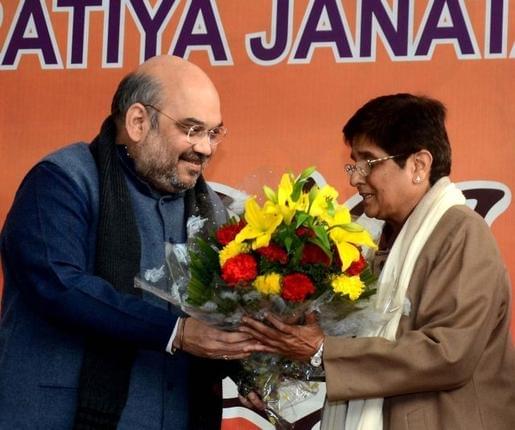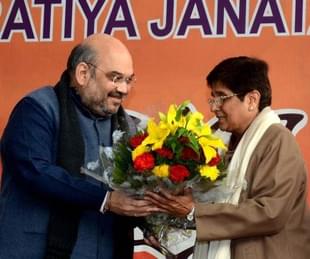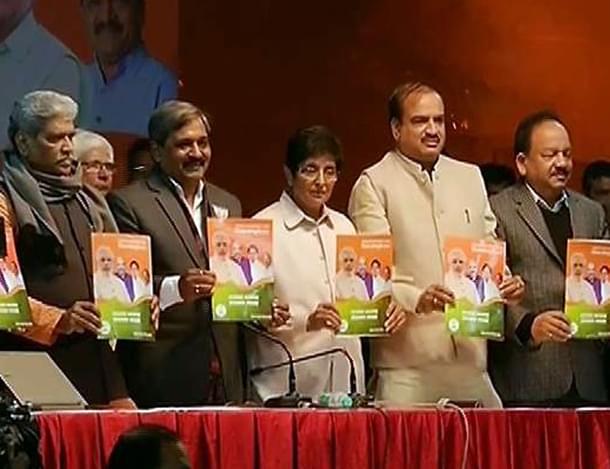Politics
Delhi Polls: Who Has The Best Manifesto?
Seetha
Feb 04, 2015, 05:48 PM | Updated Feb 18, 2016, 12:23 PM IST
Save & read from anywhere!
Bookmark stories for easy access on any device or the Swarajya app.


As far as election manifestos go, both BJP’s and AAP’s are flawed documents. But the BJP one seems to have been put together in a hurry.
Guess which of the two main parties in the fray for the Delhi Assembly is talking about bringing prices of fruits and vegetables under control and setting up a Department of Public Security to look into everything from food security to security of the home? And which party is promising `trader-friendly policies’, ending inspector raj and bringing in competition into electricity supply?
If your answer to the first is the Aam Aadmi Party (AAP), you would be wrong. These promises, which would do a Stalinist party proud, are part of the Vision Document 2015 that the Bharatiya Janata Party (BJP) released today.
And if your answer to the second question is the BJP, you would be partially correct. Yes, these promises figure in its document. But they are also part of the manifesto of AAP, which has earned itself a leftist tag, thanks to constantly targeting the corporate sector, viewing free markets and private sector with suspicion and its dole-freebie-centric approach to welfare.

Indeed, if it weren’t for the AAP logo at the top of each page in one and the orange tint, lotus watermark and `Let’s go with Modi’ in a green band at the bottom of each page in the other, anyone reading the two documents would get confused about which party’s manifesto/ vision document he was reading. On crucial issues, the two parties take remarkably similar positions.
– Audit of power distribution companies (discoms), bringing them under the Right to Information Act. Check.
– Introducing competition among discoms. Check.
– Cheaper water bills. Check.
– Rainwater harvesting, ensuring Yamuna river is not polluted by sewage. Check.
– Regularisation of unauthorised colonies and redevelopment of slums. Check
– Better public health facilities and cheaper medicines. Check.
– Making Delhi an easier place to do business in. Check.
– Protecting e-rickshaws, rickshaws, improving roads, corridors for cyclists. Check.
You get the picture.
Considering the BJP’s vision document came out several days after the AAP manifesto, it cannot avoid the jibe of being a copycat document. Worse, it comes across as a slapdash effort, something hurriedly put together to fulfil an obligation. It’s not just the couple of incomplete sentences here and the grammatical and punctuation errors there; it’s the sense it gives that many of the promises have been tossed in at the last moment, without any thought being given to them.
What is one to make of the promise to set up a Garhwali-Kumaoni Academy? Even as a way to woo the Garhwali-Kumaoni community, it boggles the mind. Or the promise to try and “provide social security, job cover, health cover and parity in salary structure of people working in the Media Sector”? Is it any government’s job to get into journalists’ salaries?
It talks about bringing down the infant mortality rate down to 15 per 1000 live births from the current 28 per 1000 live births, without specifying how. Will it work to increase institutional deliveries, a promise AAP makes? Where is the perspective in dealing with food inflation – why the silence on middlemen monopolies in the mandis? Was it deliberate, to protect a vote bank?
In contrast, the sop-laden AAP manifesto comes out looking better. There is a lot in it to find fault with, but one cannot deny that it is a cogent document. AAP has probably been working on it for longer, but that cannot be an excuse the BJP can hide behind. The fact that it did not have a document ready till the last minute, when everyone knew elections would happen, only underscores the utter disarray the Delhi unit of the party was in.
The AAP manifesto clearly sets out the background to every promise, flawed as they may be. In the case of the BJP document, one is left wondering what prompted a promise and what exactly it means. It talks about awarding scholarships only on the basis of family income, “to avoid bias of any kind”. Does that mean caste-based reservations will go? Is 85 per cent reservation in colleges for students from Delhi schools fair, in a city to which people are transferred? When the Right to Education Act is ending up closing down budget private schools catering to the poor, what implications will the promise to strengthen the Act and make its implementation more effective have?

That said, the BJP document is a tad more realistic than the AAP manifesto on quite a few counts. AAP has promised pit-head power plants “to comprehensively solve Delhi’s electricity problem in the long run by being able to meet peak power consumption of 62000 MW”. A pithead power station has to be set up near a coal mine. Is there any coal mine in Delhi or its neighbouring states? Setting up a greenfield power station isn’t like setting up a factory. Construction and commissioning takes at least four years and this does not include time spent in land acquisition and sundry permissions. And does Delhi have the money for this?
The BJP document also stays away from promising free water and power, even as it promises subsidised power for the poor and rationalising water rates. Water rates need to be hiked in Delhi to stop the middle class from wasting it, but this is at least better than providing free water. Fortunately, the BJP keeps silent about doing away with the 10 per cent annual hike in water tariffs, something AAP does.
Much is being made of the fact that the AAP manifesto promises full statehood for Delhi – one of the few points on which the two documents are different. But this doesn’t matter in real terms. Full statehood is something that only the central government can give. When the United Progressive Alliance government did not oblige when the Congress was in power in Delhi, can one seriously expect a BJP government to indulge a highly antagonistic AAP government on this count? And it can grant statehood if a BJP government is in power even if it is not an election promise. There is nothing an AAP government can do about it, barring going on dharnas (which will only backfire against it) and blaming all its failures on the lack of statehood (which will not wash after some time – after all the Sheila Dixit government delivered a lot without being a full state).
Yet, if the battle is only of the manifestos, AAP may probably have an edge. The BJP document is neither too populist to sway the masses nor rational enough to give the impression of a wise government. Perhaps it is best for it to pray that manifestoes don’t matter and that voters are swayed only by the `Let’s go with Modi’ line.
One week from now, we’ll know what worked.
Seetha is a senior journalist and author





